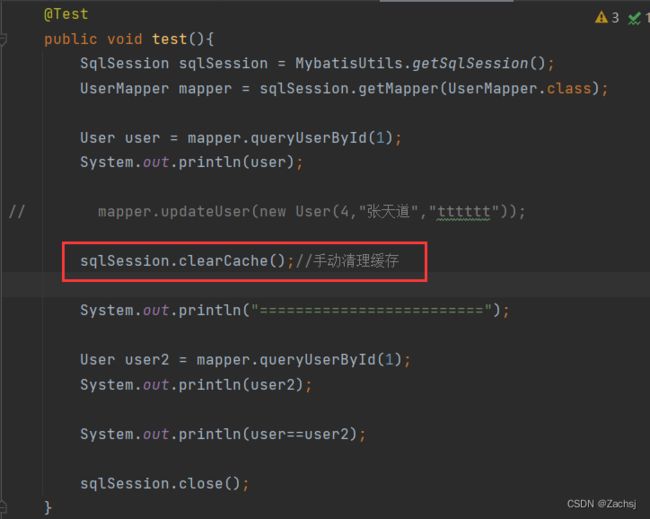Java(Mybatis03)
Java(Mybatis03)
参考视频:22. 动态SQL环境搭建(狂神)
12. 动态SQL
- 什么是动态sql:动态sql就是根据不同的条件生成不同的sql语句。
- 利用动态SQL这一特性可以“摆脱”这种痛苦…
- if
- choose (when, otherwise)
- trim (where, set)
- foreach
- 如果你之前用过 JSTL 或任何基于类 XML 语言的文本处理器,你对动态 SQL 元素可能会感觉似曾相识。在 MyBatis 之前的版本中,需要花时间了解大量的元素。借助功能强大的基于 OGNL 的表达式,MyBatis 3 替换了之前的大部分元素,大大精简了元素种类,现在要学习的元素种类比原来的一半还要少。
12.1 搭建环境
- sql
CREATE TABLE `blog`(
`id` VARCHAR(50) NOT NULL COMMENT '博客id',
`title` VARCHAR(100) NOT NULL COMMENT '博客标题',
`author` VARCHAR(30) NOT NULL COMMENT '博客作者',
`create_time` DATETIME NOT NULL COMMENT '创建时间',
`views` INT(30) NOT NULL COMMENT '浏览量'
)ENGINE = INNODB DEFAULT CHARSET = utf8;
- 创建一个基础工程
- 导包
- 编写配置文件
- 编写实体类
package com.zach.pojo;
import lombok.Data;
import java.util.Date;
@Data
public class Blog {
private String id;
private String title;
private String author;
private Date createTime;//属性名和字段名不一致
private int views;
}
- 编写实体类对应的Mapper接口 和 Mapper.xml文件
- BlogMapper
package com.zach.dao;
import com.zach.pojo.Blog;
public interface BlogMapper {
//插入数据
int addBlog(Blog blog);
}
- BlogMapper.xml
DOCTYPE mapper
PUBLIC "-//mybatis.org//DTD Config 3.0//EN"
"http://mybatis.org/dtd/mybatis-3-mapper.dtd">
<mapper namespace="com.zach.dao.BlogMapper">
<insert id="addBlog" parameterType="blog">
insert into blog (id, title, author, create_time, views)
values (#{id},#{title},#{author},#{createTime},#{views});
insert>
mapper>
- IDutils
package com.zach.pojo;
import org.junit.Test;
import java.util.UUID;
@SuppressWarnings("all")//抑制警告
public class IDutils {
public static String getId(){
return UUID.randomUUID().toString().replaceAll("-","");
}
}
- mybatis-config.xml(修改)
<mappers>
<mapper class="com.zach.dao.BlogMapper"/>
mappers>
- MyTest - addInitBlog()
@Test
public void addInitBlog(){
SqlSession session = MybatisUtils.getSqlSession();
BlogMapper mapper = session.getMapper(BlogMapper.class);
Blog blog = new Blog();
blog.setId(IDutils.getId());
blog.setTitle("Mybatis如此简单");
blog.setAuthor("狂神说");
blog.setCreateTime(new Date());
blog.setViews (9999) ;
mapper.addBlog(blog);
blog.setId(IDutils.getId());
blog.setTitle("Java如此简单");
mapper.addBlog(blog);
blog.setId(IDutils.getId());
blog.setTitle("Spring如此简单");
mapper.addBlog(blog);
blog.setId(IDutils.getId());
blog.setTitle("微服务如此简单");
mapper.addBlog(blog);
session.close();
}
12.2 if
- BlogMapper
//查询博客
List<Blog> queryBlogIF(Map map);
- BlogMapper.xml
<select id="queryBlogIF" parameterType="map" resultType="blog">
select *
from blog
where 1=1
<if test="title != null">
and title = #{title}
if>
<if test="author != null">
and author = #{author}
if>
select>
- MyTest
@Test
public void queryBlogIF(){
SqlSession sqlSession = MybatisUtils.getSqlSession();
BlogMapper mapper = sqlSession.getMapper(BlogMapper.class);
HashMap map = new HashMap();
// map.put("title","Java如此简单");
map.put("author","狂神说");
List<Blog> blogs = mapper.queryBlogIF(map);
for (Blog blog : blogs) {
System.out.println(blog);
}
sqlSession.close();
}
12.3 choose(when,otherwise)
- BlogMapper
//查询博客2
List<Blog> queryBlogChoose(Map map);
- BlogMapper.xml
<select id="queryBlogChoose" parameterType="map" resultType="blog">
select *
from blog
<where>
<choose>
<when test="title != null">
title = #{title}
when>
<when test="author != null">
author = #{author}
when>
<otherwise>
views = #{views}
otherwise>
choose>
where>
select>
- MyTest
@Test
public void queryBlogChoose(){
SqlSession sqlSession = MybatisUtils.getSqlSession();
BlogMapper mapper = sqlSession.getMapper(BlogMapper.class);
HashMap map = new HashMap();
// map.put("title","Java如此简单");
// map.put("author","狂神说");
map.put("views",9999);
List<Blog> blogs = mapper.queryBlogChoose(map);
for (Blog blog : blogs) {
System.out.println(blog);
}
sqlSession.close();
}
12.4 trim(where,set)
- where
- BlogMapper.xml
<select id="queryBlogIF" parameterType="map" resultType="blog">
select *
from blog
<where>
<if test="title != null">
title = #{title}
if>
<if test="author != null">
and author = #{author}
if>
where>
select>
- set
- BlogMapper.xml
<select id="updateBlog" parameterType="map">
update blog
<set>
<if test="title != null">
title = #{title},
</if>
<if test="author != null">
author = #{author}
</if>
</set>
<where>
id = #{id}
</where>
</select>
- trim
- where 元素只会在子元素返回任何内容的情况下才插入 “WHERE” 子句。而且,若子句的开头为 “AND” 或 “OR”,where 元素也会将它们去除。
- 如果 where 元素与你期望的不太一样,你也可以通过自定义 trim 元素来定制 where 元素的功能。比如,和 where 元素等价的自定义 trim 元素为:
<trim prefix="WHERE" prefixOverrides="AND |OR ">
...
trim>
- prefixOverrides 属性会忽略通过管道符分隔的文本序列(注意此例中的空格是必要的)。上述例子会移除所有 prefixOverrides 属性中指定的内容,并且插入 prefix 属性中指定的内容。
- 用于动态更新语句的类似解决方案叫做 set。set 元素可以用于动态包含需要更新的列,忽略其它不更新的列。比如:
<update id="updateAuthorIfNecessary">
update Author
<set>
<if test="username != null">username=#{username},if>
<if test="password != null">password=#{password},if>
<if test="email != null">email=#{email},if>
<if test="bio != null">bio=#{bio}if>
set>
where id=#{id}
update>
- 这个例子中,set 元素会动态地在行首插入 SET 关键字,并会删掉额外的逗号(这些逗号是在使用条件语句给列赋值时引入的)。
- 或者,你可以通过使用trim元素来达到同样的效果:
<trim prefix="SET" suffixOverrides=",">
...
trim>
- 注意,我们覆盖了后缀值设置,并且自定义了前缀值。
- 所谓的动态SQL,本质还是SQL语句,只是我们可以在SQL层面,去执行一个逻辑代码。
12.5 SQL片段
- 有的时候,我们可能会将一些功能的部分抽取出来,方便复用。
- 使用SQL标签抽取公共的部分
<sql id="if-title-author">
<if test="title != null">
title = #{title}
if>
<if test="author != null">
and author = #{author}
if>
sql>
- 在需要使用的地方使用include标签引用即可
<select id="queryBlogIF" parameterType="map" resultType="blog">
select *
from blog
<where>
<include refid="if-title-author">include>
where>
select>
- 注意事项:
- 最好基于单表来定义SQL片段!
- 不要存在where标签!
12.6 foreach
select * from user where 1=1 and
<foreach item="id" colliection="ids"
open="(" separator="or" close=")">
#{id}
foreach>
(id=1 or id=2 or id=3)
- BlogMapper.xml
<select id="queryBlogForeach" parameterType="map" resultType="blog">
select *
from blog
<where>
<foreach collection="ids" item="id" open="and (" close=")" separator="or">
id = #{id}
foreach>
where>;
select>
- 动态SQL就是在拼接SQL语句,我们只要保证SQL的正确性,按照SQL的格式,去排列组合就可以了
- 建议:
- 先在mysql中写出完整的SQL语句,再去对应地修改成我们需要的动态SQL,实现通用即可。
13. 缓存(了解)
13.1 简介
- 什么是缓存(cache)?
- 存在内存中的临时数据。
- 将用户经常查询的数据放在缓存(内存)中,用户去查询数据就不用从磁盘上(关系型数据库数据文件)查询,从缓存中查询,从而提高查询效率,解决了高并发系统的性能问题。
- 为什么使用缓存?
- 减少和数据库的交互次数,减少系统开销,提高系统效率
- 什么样的数据能使用缓存?
- 经常查询并且不经常改变的数据。
13.2 Mybatis缓存
- mybatis包含一个非常强大的查询缓存特性,它可以非常方便地定制和配置缓存。缓存可以极大的提高查询效率。
- mybatis系统中默认定义了两级缓存:一级缓存和二级缓存
- 默认情况下,只有一级缓存开启。(sqlsession级别的缓存,也称为本地缓存)
- 二级缓存需要手动开启和配置,它是基于namespace级别的缓存。
- 为了提高扩展性,mybatis定义了缓存接口Cache。我们可以通过实现Cache接口来自定义二级缓存。
13.3 一级缓存
- 一级缓存也叫本地缓存:SqlSession
- 与数据库同一次会话期间查询到的数据会放到本次缓存中。
- 以后如果需要获取相同的数据,直接从缓存中拿,没必须再去查询数据库。
- 测试步骤:
- 开启日志
- mybatis-config.xml
<settings>
<setting name="logImpl" value="STDOUT_LOGGING"/>
settings>
- 测试再一个session中查询两次相同的记录
@Test
public void test(){
SqlSession sqlSession = MybatisUtils.getSqlSession();
UserMapper mapper = sqlSession.getMapper(UserMapper.class);
User user = mapper.queryUserById(1);
System.out.println(user);
System.out.println("=========================");
User user2 = mapper.queryUserById(1);
System.out.println(user2);
System.out.println(user==user2);
sqlSession.close();
}
- 缓存失效的情况:
- 查询不同的东西。
- 增删改操作,涉及到改变了数据库的操作,必须刷新缓存:

- 查询不同的Mapper.xml(也是查询不同的东西)。
- 手动清理缓存:

- 小结:
- 一级缓存默认开启,只在一次SqlSession中有效,也就是拿到连接直到关闭连接这个区间段。
- 一级缓存就是一个Map。
13.4 二级缓存
- 二级缓存也叫全局缓存,一级缓存作用域太低了,所以诞生了二级缓存。
- 基本namespace级别的缓存,一个名称空间,对应一个二级缓存。
- 工作机制:
- 一个会话查询一个数据,这个数据就会被放到当前会话的一级缓存中。
- 如果当前会话关闭了,这个会话对应的一级缓存就没了,但是我们想要的是,会话关闭了,一级缓存中的数据被保存到二级缓存中。
- 新的会话查询信息,就可以直接从二级缓存中获取内容。
- 不同的mapper查出的数据会放在自己对应的缓存(map)中。
- 开启二级缓存步骤:
- 开启全局缓存:
- mybatis-config.xml
<setting name="cacheEnabled" value="true"/>
- 在要使用二级缓存的Mapper中开启
<cache/>
- 也可以自定义参数
<cache eviction="FIFO"
flushInterval="60000"
size="512"
readOnly="true"/>
- 测试
- 问题:我们需要将实体类序列化!否则会报错!
caused by: java.io.NotserializableException: com.kuang.pojo.user
- test
@Test
public void test(){
//sqlSession1
SqlSession sqlSession1 = MybatisUtils.getSqlSession();
UserMapper mapper1 = sqlSession1.getMapper(UserMapper.class);
User user1 = mapper1.queryUserById(1);
System.out.println(user1);
sqlSession1.close();
//sqlSession2
SqlSession sqlSession2 = MybatisUtils.getSqlSession();
UserMapper mapper2 = sqlSession2.getMapper(UserMapper.class);
User user2 = mapper2.queryUserById(1);
System.out.println(user2);
System.out.println(user1==user2);
sqlSession2.close();
}
- 小结:
- 只要开启了二级缓存,在同一个Mapper下都有效。
- 所有的数据优先放在一级缓存中。
- 但是当会话被提交,或者被关闭后,就会提交至二级缓存中!
13.5 缓存原理
- 用户先查二级缓存,没有再查一级缓存,再没有再查数据库,查到同时提交至一级缓存。
13.6 自定义缓存-Ehcache
- Ehcache是一种广泛使用的开源Java分布式缓存。主要面向通用缓存。
- 现在多用Redis
- 如果要在程序中使用Ehcache,先导包。
- pom.xml
<dependency>
<groupId>org.mybatis.cachesgroupId>
<artifactId>mybatis-ehcacheartifactId>
<version>1.1.0version>
dependency>
- 在mapper中指定使用我们的ehcache缓存实现!
- UserMapper.xml
<cache type="org.mybatis.caches.ehcache.EhcacheCache"/>
- ehcache.xml
<ehcache xmlns:xsi="http://www.w3.org/2001/XMLSchema-instance"
xsi:noNamespaceSchemaLocation="http://ehcache.org/ehcache.xsd"
updateCheck="false">
<diskStore path="./tmpdir/Tmp_EhCache"/>
<defaultCache
eternal="false"
maxElementsInMemory="10000"
overflowToDisk="false"
diskPersistent="false"
timeToIdleSeconds="1800"
timeToLiveSeconds="259200"
memoryStoreEvictionPolicy="LRU"/>
<cache
name="cloud_user"
eternal="false"
maxElementsInMemory="5000"
overflowToDisk="false"
diskPersistent="false"
timeToIdleSeconds="1800"
timeToLiveSeconds="1800"
memoryStoreEvictionPolicy="LRU"/>
ehcache>
- 目前至少是Redis数据库需要做缓存。(K-V)
14. 29道练习题实战!
- 略


